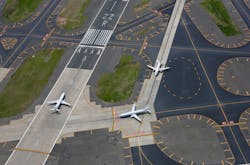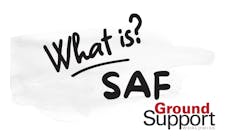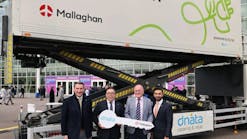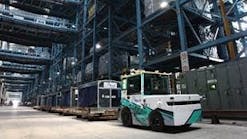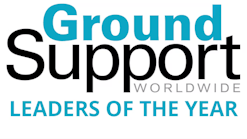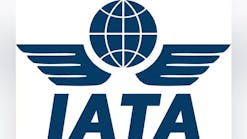Q&A: How SAF Factors into the Future of Aviation
Q: What role will sustainable aviation fuel play in the sector’s efforts to reduce emissions?
Ashleigh McDougall: Alongside low carbon technologies and high-quality nature-based carbon credits, sustainable aviation fuel (SAF), is the only alternative to conventional fuel currently available, will play a vital role in the decarbonization of the aviation sector.
Typically, SAF can reduce lifecycle emissions by up to 80 percent when used neat[1], however, there is not a standard or uniform overall carbon intensity reduction for each type of SAF. The overall lifecycle carbon savings are dependent on technology and feedstock used in the production of the fuel, blending ratios with conventional jet fuel and overall supply chain.
However, pre-COVID, the International Civil Aviation Organization (ICAO) stated that if 100 percent of conventional aviation fuel was replaced with SAF there could be a 63 percent reduction in CO2 emissions from international flights in 2050[2]. This means that SAF could be aviation’s most significant contribution towards achieving carbon neutral growth.
Q: Who is using SAF, how is it made available and how much does it cost?
AM: Every party that benefits from flight can play a role in reducing emissions – and there are many airlines – from commercial to cargo – and airports around the world that are taking positive steps when it comes to using SAF. But despite the progress that has been made, today’s commercial production is only a fraction of total jet fuel consumption, and it remains costly compared to conventional jet fuel. In order to increase the supply of SAF, the industry needs to collaborate to rapidly scale up the production of SAF volumes.
Shell Aviation is working to collaborate, to supply and to invest, all with the aspiration of offering SAF as a significant part of our fuels’ portfolio. To this end, Shell recently announced its ambition to produce around 2 million tonnes of SAF a year, increasing SAF sales to represent 10 percent of global aviation fuel customer purchases by 2030.
This ambition is underpinned by a focus on making investments for the long-term, from world-scale production facilities through to emerging technologies. For example, Shell recently announced a final investment decision to build one of Europe’s biggest biofuels facilities at Shell Energy and Chemicals Park Rotterdam, expected to start production in 2024. SAF could make up more than half of the 820,000-tonnes-a-year capacity, meaning the facility will be among the biggest in Europe to produce SAF made from waste.
Q: The industry currently faces a supply and demand challenge for SAF, what can be done to address this issue?
AM: The SAF supply chain faces a “chicken and egg” problem with supply and demand: costs will come down if production scales up, but fuel providers are lacking a consistent demand signal to increase production and demand is low due to the high price premium.
We believe that mandates are an essential and foundational element to addressing this, helping to encourage uptake and unlock learning curve effects and economies of scale which could lower costs. Mandates should ideally be aligned globally, technology agnostic, be ambitious but consistent with pace to build supply capabilities and infrastructure and increase over time as production scales up.
Once mandates are in place as a foundation, we can begin to add the other measures to complement them, such as fiscal incentives.
Q: How important is the role of government, and how can policy mechanisms help scale SAF supply and demand?
AM: Both fuel suppliers and airlines need to have a shared requirement to help develop SAF. In order to support consistent demand, it is important that the industry and governments work together to develop SAF in a structural way by looking at both the demand and supply side of the industry. Specifically, in terms of financial support, governments have a role to play, with policies that recognize that SAF can be between 2-5 times more expensive than conventional fuel and so will need to provide some form of financial support mechanisms.
We are actively engaging with governments, regulators and other stakeholders across the industry to help shape the right ambitions and policies for the industry. From an international standpoint, as a founding member of the World Economic Forum’s Clean Skies for Tomorrow Coalition (CST), Shell Aviation has been working with leaders across aviation and governments to identify supportive policy measures that can help accelerate aviation’s progress towards net-zero emissions.
As well as engaging on an international level, national forums are also an effective way of creating moment positive momentum on sustainable aviation. Shell is a member of the Sustainable Aviation Roundtable in the Netherlands and the UK Government's Jet Zero Council.
Q: Which challenges can be overcome through partnerships and where are the synergies along the value chain?
AM: Decarbonizing the aviation industry requires collaboration; no one company can do it alone. All parties involved — SAF producers and suppliers, airlines, airports and OEMs — can offer valuable insights, technical expertise and capabilities that can help the industry to reach net-zero. This can deliver benefits for both the development of new innovations and as well as collaborating to find ways to unlock the emissions reduction potential of technology that is already in use today.
For example, we recently signed an agreement with Rolls-Royce to progress the use of SAF and shape policies that support a net zero pathway for the industry. Combining Rolls-Royce’s industry-leading engine design and manufacturing capabilities with Shell’s expertise in fuel, lubricants and carbon management solutions, the agreement brings together complementary skillsets that can help accelerate the aviation industry’s decarbonization efforts.
Q: Are there any current examples of governments having a positive impact on SAF adoption?
AM: Aside from introducing policies and financial support to help increase the production, supply and demand for SAF, it’s important that we view policymakers and governments as being part of the wider aviation ecosystem. This means industry, governments, regulators, trade bodies and companies from right across the aviation value chain, all working collaboratively towards a shared aim of reaching net-zero emissions.
In particular, governments have an important role in supporting and encouraging innovation from industry. A recent example of this would be the challenge set by the Dutch Ministry of Infrastructure and Water Management to produce 500 liters of synthetic kerosene, which was accepted by Shell and KLM. I‘m proud that Shell successfully delivered on this challenge - producing the synthetic kerosene in our Shell Technology Centre Amsterdam using CO2, water and renewable energy.
So what started with an innovative industry challenge set by the Dutch government, ended with the world’s first flight using certified, synthetic kerosene made from hydrogen and recycled carbon. By demonstrating the possibility to produce SAF via alternative technologies and processes, we are showing the feasibility of an innovative, lower-carbon pathway for making SAF.
Q: What infrastructure needs are required for airports to store SAF? Will fuel farms need to be expanded, upgraded, or otherwise altered? Similarly, are there any HSE requirements for handling SAF?
AM: SAF is a ‘drop in’ solution – it is fully Jet A/A-1 compliant and has the same characteristics and specifications as conventional fossil jet fuel. It can be supplied through existing airport refueling infrastructure and can be used by airlines without requiring technical modification to their current fleets.
SAF is currently only approved when it is blended at no more than 50 percent with conventional jet fuel. In late 2020, Shell and Rolls-Royce worked together to conduct 100 percent SAF tests in two engines – a Trent 1000-based demonstrator in Derby, UK, and a Pearl 700 Business Aviation engine in Dahlewitz, Germany, the former with a lean-burn combustor and the latter with a rich-burn combustor. The main aim of the tests was to focus on the operability of the engines in order to enhance our technical understanding of the benefits of running on 100 percent SAF compared to Jet-A1. The results were similarly positive across both engines which ran for a combined total of 20 hours.
The results could be significant for how SAF could be used by the industry in commercial operations. They could lay the groundwork for moving such fuels towards certification, removing barriers to entry by increasing the flexibility of introducing sustainable fuels within existing supply chains.
[1] IATA
Ashleigh McDougall is head of Europe and South Africa at Shell Aviation.
